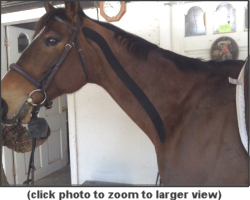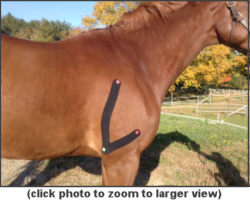Don’t Ever Close the Door to Learning:
When I was asked several years ago about what
I knew about kinesio taping I smugly chuckled to myself and replied
“ We have been taping for years to immobilize joints and and soft
tissue structures, so what is the big deal?” After I said that
ignorant statement, I thought, “ Don’t close the door to learning.
Keep an open mind and do a little research before discounting
something new”. Well, I called a few human physio’s whom I respect
in the field and found that they had been kinesio taping
professional athletes for many years and found it very helpful. I
did extensive research, and read the original books published by
Kenzo Kase, D.C. founder of kinesio taping. I traveled to the
physio’s office and worked with them to learn how to kinesio tape.
Under their tutelage, I taped their clients who were marathon
runners, tennis and football players, and injured athletes. I spent
an extensive amount of time taping human athletes, and riders before
I went on to taping horses. The humans were able to give me
immediate feedback. Guess what? I learned kinesio taping gave an
athlete an advantage and the ability to compete and perform with a
slight to moderate injury. It can be used for preventative
maintenance as well, though it is not the Holy Grail. On to horses!
"Kinesio Taping is Fundamentally Different from Conventional
Sports Taping"
History of Kinesio Taping:
“Kinesio taping is a modality treatment based
on the body’s own natural healing process. The Kinesio Taping method
exhibits its efficacy through the activation of the neurological and
circulatory systems. This method basically stems from the science of
Kinesiology, recognizing the importance of body and muscle movement
in rehabilitation and everyday life. Muscles contribute not only to
the movements of the body, but also aid in the circulation of venous
and lymph flows, and body temperature. Therefore, the failure of the
muscles to function properly induces various kinds of health
maladies.
For the first 10 years, orthopedists,
chiropractors, acupuncturists and other medical practitioners were
the main users of Kinesio Taping. Kinesio Taping was soon discovered
by Olympic volleyball players for preventative maintenance in Japan
and word spread to other athletes. Today, Kinesio Taping is accepted
by medical practitioners and athletes through out the world.”
How Does it Effect Muscles:
“Muscles extend (lengthen) and contract
(shorten) within a normal range; however when muscles over-extend or
over-contract, such as lifting an excessive amount of weight, or
overstretching (like in lengthenings in dressage), muscles may
undergo microscopic tears in the tissue and recovery is slowed down
and the muscles may become inflamed. When a muscle is inflamed,
swollen or stiff due to fatigue, the space between the skin covering
the muscle is compressed, resulting in constriction to the flow of
lymphatic fluid. This compression also applies pressure to the pain
receptors (part of the nervous system) beneath the skin, which in
turn communicates “discomfort signals” to the brain. The person
interprets these signals as Pain. It is believed when the skin is
lifted by the elastic tape, the flow of blood and lymphatic fluid
beneath the skin improves.”
Difference Between Conventional Sports and Kinesio Taping:
“Conventional athletic tape, which I was
familiar with, was designed to constrict and immobilize movement of
affected muscles and joints, by using the tape to apply significant
pressure and tightness resulting in the restriction of the body part
and bodily fluids. It is generally applied before the sports
activity, and immediately removed after the activity. Kinesio Taping
allows free range of motion to the joint or muscle allowing the
body’s muscular system to heal itself bio-mechanically with a
specific tape elasticity that does not restrict or allow for an
overstretch. “
Some Major Functions of Kinesio Taping:
1. Supports Muscle by:
 Improving muscle contraction in weakened
muscle Improving muscle contraction in weakened
muscle
 Reducing muscle fatigue Reducing muscle fatigue
 Reducing over-extension and
over-contraction of muscle Reducing over-extension and
over-contraction of muscle
 Reducing cramping and possible injury to
muscle Reducing cramping and possible injury to
muscle
 Increasing Range of Motion
and Relieving Pain Increasing Range of Motion
and Relieving Pain
2. Removes Congestion to the flow of Body
Fluids
 Improves blood and lymphatic circulation Improves blood and lymphatic circulation
 Reduces Excess Heat and Substances in Tissue Reduces Excess Heat and Substances in Tissue
 Reduces Inflammation Reduces Inflammation
 Reduces
Abnormal Feeling and Pain in Skin and Muscle Reduces
Abnormal Feeling and Pain in Skin and Muscle
Differences in Application of Tape:
“To Stretch or Not to Stretch:"
Depending on what results I am looking for in
the application and use of the Kinesio tape, I will use the
following rules of thumb:
1. For overused or acute muscle injury:
Apply tape with No Tension, which normally amounts to 5-10% elastic
stretch, and connect the tape from the muscle Insertion to the
muscle Origin.
2. For chronic or acutely weak muscles,
where support with full range of motion is needed, the tape should
be applied from Origin to Insertion. The tape should be
applied with Light Tension to give more stimulation and support the
contraction of the muscle during its use. The tape should be applied
with medium to full Stretch, maintaining a functional joint position
during application to joints and ligaments for correction and
assistance.” Do not tape on open skin lesions or skin with hair.
My Work with Kinesio Taping Horses:
I have found kinesio taping horses has been
very useful when a horse is very tight in their muscles or has
sustained a slight muscle strain. Since the tape is meant for use on
skin, it may not stick that well to the horse’s hair. I have had
tremendous success in restoring range of motion when I have applied
the Wilson Meagher Method of Sportsmassage to the muscles of the
horse, and then applied the kinesio tape when warranted. I mostly
use kinesio taping when I work at top International competitions. It
is at these competitions that the horses tend to go beyond their
athletic barriers and respond well to the combination of sports
massage therapy and kinesio taping to sustain and improve their
performance. It’s use can always be used with all horses of all
levels and disciplines as well.
I have also taped riders and they have
reported that the taping in conjunction with the sportsmassage
method has made them immediately feel better.
Explanation of the Photographs of Taped
Muscles:The photographs portray examples of taping specific
muscles.
 This
young, Off-the-Track Thoroughbred was having extreme difficulty
turning his head and neck to the right. The neck muscles were very
tight, but specifically the Brachiocephalicus muscle was very tight,
restricting a lateral bend in the neck to the right. He was also
short in the left front on a circle going to the right. This
young, Off-the-Track Thoroughbred was having extreme difficulty
turning his head and neck to the right. The neck muscles were very
tight, but specifically the Brachiocephalicus muscle was very tight,
restricting a lateral bend in the neck to the right. He was also
short in the left front on a circle going to the right.
The black kinesio tape was placed from the
insertion of the brachiocephalicus muscle to the origin. The
insertion of this muscle is where the motion occurs. The origin is
the anchor of the muscle or stabilizer. The insertion is on the
humerus and on the fascia of the shoulder and arm. (near point of
shoulder). The origin is near his skull, poll, and above mid neck.
I started taping at the insertion, near the
point of the shoulder, with very little to no tension. I taped to
the top of his neck near the origin. This immediately allowed the
horse’s muscle to relax in order to bend his head and neck and
resume good motion on a circle in both directions!! Taping from
insertion to origin with up to 20% tension helps to release a tight
muscle.
 This
horse was resistant to picking up the right lead at the canter. I
found the right long and short heads of the triceps to be
particularly tight. The triceps essentially flex the shoulder,
extend the elbow, and by doing these actions, they bring the front
leg back. If the triceps are tight, they do not relax enough to
allow the leg to extend, or go forward, thus resisting the right
lead at the canter. After applying my sportsmassage method, I taped
the right long head of the tricep from the insertion marked with a
light green circle, to the origin marked with a light red circle. (a
longer vertical line going up toward the withers). I then taped the
short head of the tricep from the insertion (light green marker) to
the origin (light red marker). This muscle runs at the base of the
shoulder. See photo above. After the sportsmassage application and the
taping, the horse immediately and easily, picked up the right lead
at the canter because I believe the taping and sportsmassage allowed
the muscle to relax in order for the leg to freely move forward. This
horse was resistant to picking up the right lead at the canter. I
found the right long and short heads of the triceps to be
particularly tight. The triceps essentially flex the shoulder,
extend the elbow, and by doing these actions, they bring the front
leg back. If the triceps are tight, they do not relax enough to
allow the leg to extend, or go forward, thus resisting the right
lead at the canter. After applying my sportsmassage method, I taped
the right long head of the tricep from the insertion marked with a
light green circle, to the origin marked with a light red circle. (a
longer vertical line going up toward the withers). I then taped the
short head of the tricep from the insertion (light green marker) to
the origin (light red marker). This muscle runs at the base of the
shoulder. See photo above. After the sportsmassage application and the
taping, the horse immediately and easily, picked up the right lead
at the canter because I believe the taping and sportsmassage allowed
the muscle to relax in order for the leg to freely move forward.
Lesson: I learned that if I closed the
door to this new modality, many horses and riders I work with would
not have received the tremendous benefits. In many ways, I would
have been denying them a proper treatment. Life is full of lessons,
just make sure the door is open. You can always dismiss the info,
once you have learned about it if it doesn’t work or make sense to
you!
Of course it is not the answer for everything
and the taping should be done in conjunction with veterinary/
physician approval and advice. Kinesio Taping is not meant as a
primary form of treatment for veterinary or medical problems without
Vet or Doctor approval.
1. All quoted material is taken directly or
indirectly from “Illustrated Kinesio Taping”. Fourth
Edition 2005 by Kenzo Kase, D. C.; KEN’I KAI INFORMATION
Publisher |

